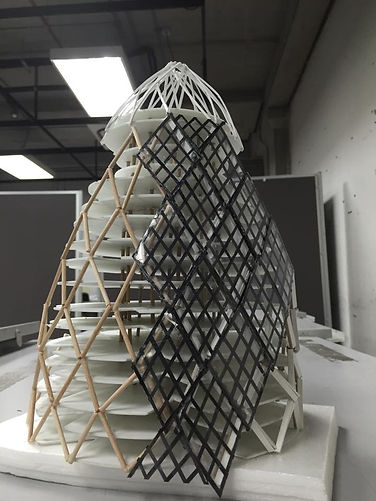
Tang Kar Jun
Architect in the Process

Building Construction 2
This project aims to teach us on the structures of buildings which relates to historical and innovative building. Matters touched upon are skeletal, surface and solid construction which makes up the core a building. Many of the projects are hands-on so we ourselves can feel the exact weight of how it is done.
Project 1: Skeletal Construction "A shelter for one"
Our task is to construct a shelter according to the following specifications.
SCALE- Our shelter should be constructed to fit for one person in a sitting position (1:1 ). Max height is 1.5m. Max base size is 0.75 x 0.75 m
CONSTRUCTION- It should demonstrate the knowledge of skeletal frames and its joints o Should be elevated at least 5 inches from the ground
JOINTS-The joints should be constructed to reflect actual joints. Eg, if a group chooses recycle steel materials for the frame, the joints should be made to resemble bolts and nuts etc. We are not allowed to use inappropriate materials for joints such as rope for steel.
MATERIALS- We are only allowed to use recycle materials such as newspaper, pet bottles, cans, etc. However, the chosen materials must relate to its function. Eg, roofing materials should not be made from newspaper.
OTHER DESIGN CONSIDERATIONS- This is just a minor component however; the shelter should be light and portable. Resistant to outdoor weather. Allows easy access in and out from the shelter o Shelter SHOULD NOT BE OVERLY DESIGN and must conform to the design criteria.
TEST-The completed shelter will be tested to withstand the weight of average 60kg person up to 2 minutes.
Analysis on the design, construction progress and test results are to be provided in the form of an A3 bound report.
We are encouraged to use annotated sketches / diagrams to explain the construction, joints, forces, structural movement experienced during the testing of the shelter.
Photographs of the shelter should also be incorporated into the presentation report.
My group found a lot of old and unused wood as well as construction cloths and decided to use them. Joints used were mainly dado and rabbet joints. The whole structure was mainly hand-sawn and also nailed up.
 1 REPORT cover.jpg |  2 REPORT intro.jpg |  3 REPORT mat.jpg |
|---|---|---|
 4 REPORT concept.jpg |  5 REPORT process.jpg |  6 REPORT progress.jpg |
 7 REPORT end.jpg |

Project 2: Understanding Forces in Solid and Surface structure
A building normally comprises of different types of structural systems, either due to its function or building code requirements. As designers it is very important that you understand when and where each of the different type of structural system is used. Solid and surface construction method is one of the most widely used structures for building support. Solid and surface structure provides the required load bearing resistance and aesthetics required by designers.
1. Group Task (20%)
1. We are to propose a building (solid construction or surface construction) and identify the different types of structural systems used in the construction of the building of your choice. We are to ensure that the building you select is using at least TWO (2) different types of structural system.
2. Describe each structural system identified in terms of Function, Material and Load distribution.
3. Produce a model showing the different structural systems used in the above building. Suitable scale and material to be used for the construction of the model shall depend entirely on you. However, do take note that quality and workmanship of the model produced will be considered in the assessment of this project.
4. We are then required to prepare ONE (1) A4 size booklet, analysing the success or failure of the model together with the mitigating measures. We are to include a brief introduction of the building, construction method, modelling process as well as detailing of different parts of the buildings to show how it is constructed.
5. We are encouraged to use annotated sketches / diagrams to explain the forces, structural movement experienced.
6. Photographs of the model and the process in making the model should also be incorporated into the A4 booklet.
1. Individual Task (10%)
1. Individually, each student is required to do a 2D detail drawing (isometric, section) to show different parts of the selected buildings complete with annotations and specifications to show understanding on how the building is constructed.
2. We must include a key drawing to show where the detail is taken from the building.
3. The drawings should be formatted in A3 size sheet complete with title block. Use appropriate scale for the detailing.

